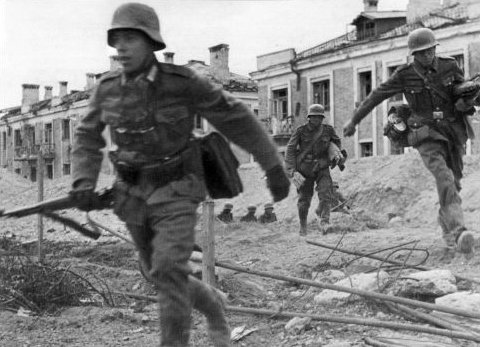Stalingrad: Ambitious Campaign, Decisive Defeat.

German Troops in Stalingrad, 1942 - Wikimedia Commons
Stalingrad, 1942. One of the greatest military disasters in Hitler's Germany began: the Battle of Stalingrad. A confrontation that involved rampant ambitions, national pride, historic rivalries and comfortable disputes to the electrifying room in this city that was the scene of one of the largest warplanes in the entire world conflict.
In the next few lines we will see what worked and what did not. I have prepared some topics to understand why it occurred, how it developed and what its outcome was.
1. Understanding the Context;
Stalingrad was in a key region for the Germans: the entrance to the Caucasus region, very close to the Black and Caspian seas, rich for its oil reserves. They were watching her and, as the attempt to defeat the USSR by Operation Barbarossa (1941) went from bad to worse, they decided to divide forces and try to conquer it. In the middle of the way, however, were the Soviet forces trying to bar them.
There was one more reason for Hitler to want to destroy it or to capture it by all possible means: the city took the name of Stalin. It would be a way of demoralizing him, humiliating him, even if virtually, and doing what he could to achieve it; in September 1942 he sent Von Weichs Army Group B to Von Paulus's 6th Army and Hoth's 4th Panzer for this purpose.
2. The clash;
As a practice of the Germans could not miss the Lightning War to start the campaign: Stalingrad was bombarded day and night by Luftwaffe planes being reduced to debris. Shortly after, the first assault with the Panzers III and all sorts of motorized troops - which can be seen by the tactical map that I prepared and is in this link down here.
Stalingrado by Guilherme Hiancki Monteiro
Soviets, led by Chuicov and Yeremenko, also owned their war chariots and troops waiting for the Germans. The southernmost group retreats more and more to the north, meeting with other members of the defensive forces and taking combat to ever-increasing levels. Weeks later, every building that remained of the intense conflict would represent a stage of this battle.
October is coming. Soviets increasingly to the north and Nazis invading the city house to house. Reinforcements reached both sides and the fight seemed to have no end; along with the new month was also approaching the freezing Russian winter, another detail that could not be outside the plans of any military commander (doubts, remember Napoleon in 1812 😀).
3. End of Battle: Beginning of the End of the Germans in Russia;
In a regional strategic plan, the Soviets moved from Stalingrad, from the defensive to the offensive about a month later. Adding three attempts the Germans were unable to defeat the defenders of the city and they were in bad conditions, a situation that was well used by the Russians: they launched an operation to surround the city and the troop of Von Paulus in a movement of pincers, causing that he surrendered in early 1943.
Russian pressure was steadily increasing, and as we have a spoiler at the end of the war, the Nazis increasingly retreat back to their homeland. In Stalingrad they paid a heavy price in one of their several failed attempts to dominate Russia: such prized fuel fields were not won, incredible numbers of casualties (both sides including civilians) and tens of thousands of German prisoners - a handful of them were released only ten years after the end of the war.
The failure to provide reinforcements and supplies and the obsessive insistence on a target almost impossible to take - some historians, including Martin Folly, author of The Palgrave Concise Historical Atlas of Second World War, point out that Hitler was almost sickly attached to the idea of taking the city - were the great military lessons that both sides learned with great difficulty.
I hope you have enjoyed this post; questions in the comments and until the next texts!
Consulted Works:
ANTILL, Peter. Stalingrad. Oxford: Osprey Publishing. 2007;
FOLLY, Martin. The Palgrave Concise Historical Atlas of Second World War. New York: Palgrave Macmillan. 2004. p. 41, 49.
Twitter
Congratulations @convhistoria! You received a personal award!
You can view your badges on your Steem Board and compare to others on the Steem Ranking
Vote for @Steemitboard as a witness to get one more award and increased upvotes!